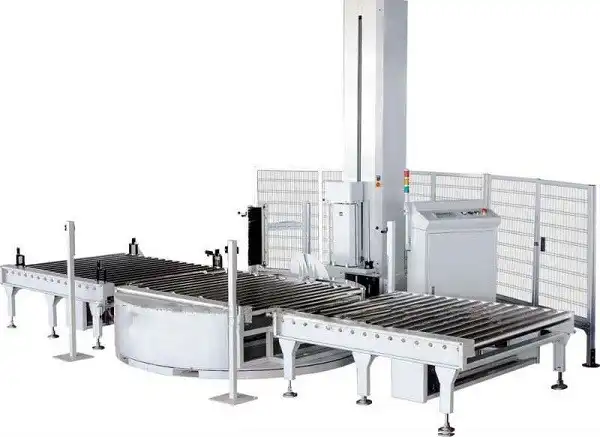Optimizing Packaging: Understanding the Pallet Stretch Wrapping Machine with Integrated Scale
The pallet stretch wrapping machine with scale represents a significant advancement in packaging technology, merging two critical logistics functions – load securing and weight verification – into a single, efficient operation. This integrated system streamlines workflows, enhances accuracy, and offers substantial benefits for warehouses, distribution centers, and manufacturing facilities.
1. What is a Pallet Stretch Wrapper with Scale?
At its core, this machine is a specialized piece of packaging equipment designed to automatically or semi-automatically wrap palletized loads with stretch film while simultaneously measuring their precise weight. It combines the functionality of a standard stretch wrapper (turntable or rotary arm) with a highly accurate industrial weighing system, typically integrated directly into the machine's base or turntable.
2. How Does the Integrated System Work?
The process integrates wrapping and weighing seamlessly:
- Loading: An operator places the palletized load onto the machine's turntable.
- Initiation: The wrapping cycle is started via the control panel.
- Weighing: As the turntable begins to rotate (or before the cycle starts, depending on the model), integrated load cells beneath the turntable measure the gross weight of the pallet and goods.
- Wrapping: Simultaneously or sequentially, the stretch film carriage moves vertically, applying stretch film around the load according to pre-set parameters (wrap count, tension, pattern).
- Data Display/Recording: The final weight is displayed on the control panel and can often be transmitted to inventory management (WMS) or shipping systems.
- Unloading: The securely wrapped and accurately weighed pallet is removed.
3. Key Components and Features
Understanding the components helps appreciate the machine's functionality:
- Turntable/Frame: The platform where the pallet sits. In scale-integrated models, this houses or sits upon the weighing mechanism.
- Weighing System (Scale): Utilizes precise load cells integrated into the base to measure weight accurately. Key parameters include:
- Capacity: Maximum weight the scale can handle.
- Resolution: Smallest weight increment the scale can detect and display.
- Stretch Film Carriage: Holds the roll of stretch film and controls its application, including pre-stretch (maximizing film efficiency) and tension control.
- Control Panel: The user interface for setting wrapping parameters (top/bottom wraps, carriage speed, rotation speed) and viewing weight data. Modern systems often feature touch screens and programmable recipes.
- Mast: The vertical structure guiding the film carriage's movement.
4. Benefits of Using a Stretch Wrapper with Scale
Integrating these two functions yields significant advantages:
- Enhanced Efficiency: Eliminates the need for separate weighing stations and double-handling of pallets, drastically reducing process time and labor requirements.
- Improved Accuracy: Provides precise weight data essential for shipping documentation (Bills of Lading), load planning, and avoiding carrier penalties for inaccurate weights.
- Space Optimization: Combines two functions into one machine footprint, saving valuable floor space in busy facilities.
- Cost Reduction: Lowers labor costs associated with separate weighing and potentially reduces material costs through optimized wrapping.
- Streamlined Data Management: Weight data can be captured automatically, reducing manual entry errors and improving inventory accuracy when integrated with WMS/ERP systems.
- Process Simplification: Consolidates operations, making workflow smoother and easier to manage.

automatic pallet stretch wrapping machine 5. Common Applications
These machines are invaluable across various industries:
- Warehousing & Distribution: For order fulfillment, inventory management, and outbound shipping preparation.
- Manufacturing: Weighing finished goods pallets before storage or shipment.
- Logistics & Freight Forwarding: Verifying shipment weights for accurate costing and compliance.
- Food & Beverage: Ensuring consistent pallet weights and secure loads for transport.
- Retail: Streamlining back-of-store operations and distribution center processes.
6. Considerations When Choosing a Machine
Selecting the right pallet wrapper scale combo involves evaluating several factors:
- Load Capacity & Size: Ensure the machine can handle your typical pallet weights and dimensions.
- Scale Accuracy & Certification: Verify the scale meets the required precision for your operations (e.g., NTEP certification if legally required for trade).
- Throughput Requirements: Match the machine's wrap speed (pallets per hour) to your operational needs.
- Level of Automation: Choose between semi-automatic (operator starts cycle) and fully automatic (integrated into conveyor lines) systems.
- Film Pre-Stretch: Higher pre-stretch capabilities (e.g., 250%+) significantly reduce film consumption.
- Integration Capabilities: Consider if you need the machine to communicate weight data directly to other business systems.
7. Maintenance and Upkeep
Regular maintenance ensures longevity and accuracy:
- Scale Calibration: Periodically calibrate the scale according to manufacturer recommendations or industry standards.
- Component Checks: Regularly inspect the turntable, film carriage, rollers, and mast for wear or damage.
- Cleaning: Keep the machine, especially the scale components, free from debris.
By combining load containment and weight verification, the pallet stretch wrapping machine with an integrated scale offers a powerful solution for optimizing packaging efficiency, accuracy, and cost-effectiveness in modern logistics and manufacturing environments.